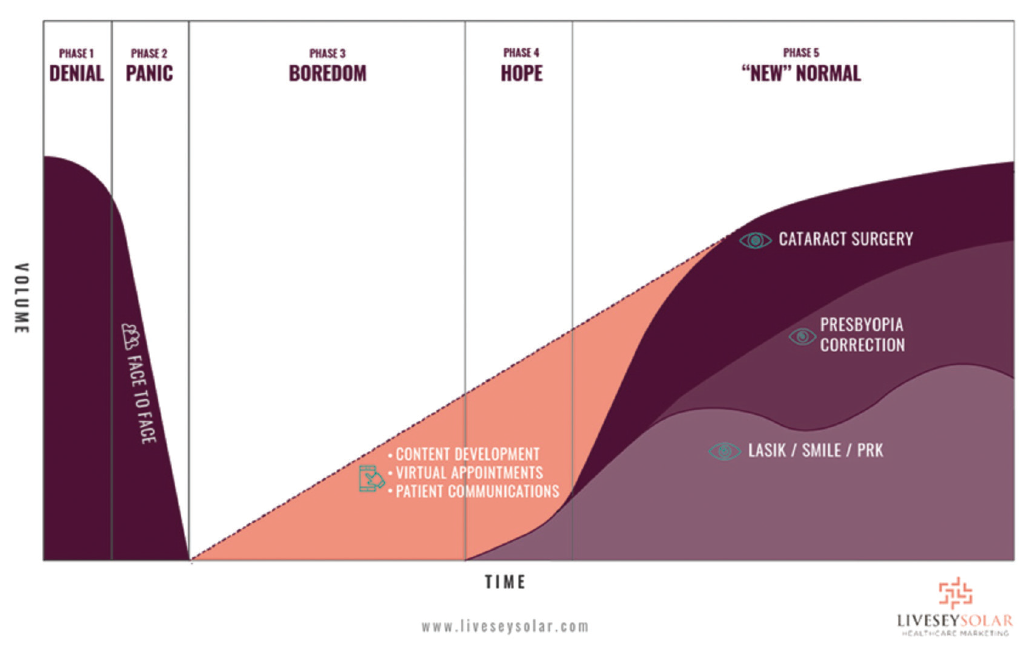

A second wave of COVID-19 infections is anticipated in Europe. Hans Kluge, the director of the World Health Organization, has warned countries that have eased lockdown restrictions that now is the “time for preparation, not celebration.”1
Unless the most optimistic models come to pass, we expect clinics worldwide to go through rolling phases of boredom, hope, and a new normal that last anywhere between 16 weeks and 2 years after shutdown. The good news is there is no need to guess what will happen and how you should respond during each phase. Considering the following guidelines can help to ease that burden.
THE FIVE PHASES OF THE COVID-19 CRISIS
We have projected a phased trajectory for the COVID-19 crisis (Figure). We’ve already been through phases 1 through 3.

Figure. The five phases impacting practice revenue during the coronavirus.
Phase No. 1: Denial (1 to 2 weeks before shutdown). In the denial phase, certain factions of your market conducted business as usual. As we expected, some patients kept their appointments because, for them, nothing changed. That was the minority, though, and they were typically the young millennials in your LASIK market.
Phase No. 2: Panic (2 to 3 weeks of shock). During the panic phase, there was an immediate and sudden contraction of supply and demand for elective health care services, as physiologic and safety needs superseded everything else.
Rather than marketing to anyone during this phase, the best use of your time was to plan your next steps by setting up the infrastructure to hold virtual appointments. This would enable practices to hit the ground running when we returned to the new normal.
Phase No. 3: Boredom (6 to 12 weeks after shutdown). In the boredom or isolation phase, patients were hungry for information and entertainment to distract them from current events and the monotony of life inside four walls.
Many elective surgeons and clinics turned off their paid traffic ads or dramatically lowered their budgets. That might not have been the best move, as the cost for pay-per-click significantly diminished. You could have gotten keywords that would usually cost you £10 to £20 for pennies on the pound. That opportunity is eroding daily, but you can still take advantage of lowered ad costs with your new messaging in the phase 4.
When the second (and possibly third and fourth) wave arrives, we’ll be back into phase 3. When this happens, you’ll need to stop selling and return to list-building. You’ll need to go back to creating and disseminating informative, educational, or entertaining content while maintaining a tone sensitive to current affairs. Most important, you’ll want to make the content interactive.
Remember, the demand for refractive and cataract surgery did not go away during the boredom phase.
Phase No. 4: Hope (12 to 16 weeks after shutdown). This is where many countries are now. Governments have begun to ease their lockdowns, and we should be through the worst of this crisis. During this phase, people will return to planning for their futures—but no one knows when consumer and business confidence will completely recover.
There has been a steep economic decline, and we can now expect a period of bumping along the bottom, like an airplane struggling to take off. The economy will recover, but it’s going to take time and patience, especially for millennial and generation Z patients, who will bear the brunt of the economic fallout.
Unless you are seconded to the front lines, you still have the luxury of time right now. You must use this time to prepare for the future. Ask yourself:
- How will I continue to generate awareness during the hope phase?
- How can I engage my audience to address some of the problems they are likely experiencing during this phase and the next?
- How can I build a list of prospective patients so that I can supply their demand in the next phase?
- How can I convert my prospects so that I can give them hope of a better future after the next phase?
Take this time to develop content that helps your prospective patients cope with what they’re going through. It could be written content, video content, or content for your website.
You can also work to optimize your website for search and reconsider the imagery you use as ways to build your audience. It might be helpful to start pivoting your content away from millennials to attract other markets, including generation Xers and baby boomers. If you’re not offering premium services, update your website and upscale your premises to reposition yourself as a luxury service. This will require you to model how much you will need to increase your prices to make up for your losses in the lean time.
Understand that luxuries are recession-proof. Although the word luxury can be synonymous with unnecessary, let’s face it: When most people are barely making ends meet, that’s what refractive surgery is.
This recession will likely mark the end of elective surgery as a commodity. Position your brand as a luxury and adjust your service level accordingly. A high-volume workflow in a social-distancing environment that might last anywhere from 6 to 12 or 18 months is not achievable. Affluent patients have high discretionary income even when consumer confidence is low. As these people emerge from their quarantine, you should raise your prices to match your social-distancing requirements.
There are other ways to be productive during the hope phase:
- Offer telemedicine appointments;
- Hire a pay-per-call phone answering service to give your patients and prospective patients a voice on the end of the line; and
- Reconsider your messaging in all automated emails: Are they offering the right call to action, or are they tone-deaf to the current reality?
In this phase, you can resume advertising—aggressively. Think of it as driving out of a curve in the road: Accelerate while everyone else comes out of it tepidly. Send traffic to your content, lead magnets, and online consultations. Pay as much as you can afford because surviving the next year depends on it.
Also, update your marketing material to contain messages related to independence, self-reliance, and self-improvement during this phase, as individuals will be looking to improve their quality of life and fortify themselves for the next existential threat.
If you haven’t already, start to plan the practice protocols you intend to introduce into your clinic once you reopen. Allowing only one patient into the clinic at a time, isolating in-person appointments, prescreening to keep suspected positive cases out of the clinic, and implementing diligent cleaning regimes between visits are excellent places to start.
Continue with online consultations. No matter how safe you feel your practice environment is, patients will be timid about returning. Once they realize how easy and efficient video appointments can be, they will demand them as part of the patient onboarding process.
This pandemic is inducing a significant fear of infection in the older generation. Take time in the hope phase to advise members of this generation on how they can safely continue with their eye surgery plans. Video appointments and telemedicine are a great medium for all ages.
Phase No. 5: The new normal (4 months to up to 2 years after shutdown). Eventually, restrictions on elective surgery will lift and you will be able to resume surgery again—for a while.
This phase will likely occur in a cyclical wave of easing and contracting, so be prepared to revert back to shutdown measures when the second bout of infection hits.
Fortunately, you now have the knowledge to pivot and address your market when the boredom, hope, and new normal phases repeat themselves.
Remember, while your competitors are busy hiding away, you can:
- Excite inactive patients with relevant and tone-sensitive content;
- Build a healthy patient pipeline with video appointments; and
- Make all the money you need to get you through the shutdown via prepaid surgery.
CONCLUSION
Consider this critical message: Don’t react. Respond. You built this practice, and you will be the one to dictate its future.
1. Mahbubani R. Business Insider. May 18, 2020. A WHO official warns of a 2nd deadly wave of the coronavirus across Europe in the fall: ‘Now is the time for preparation, not celebration. https://www.businessinsider.com/europe-prepare-second-deadly-coronavirus-wave-fall-who-2020-5. Accessed May 26, 2020.


